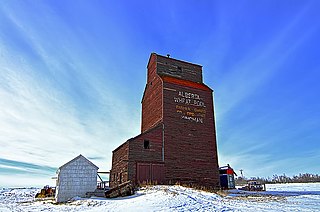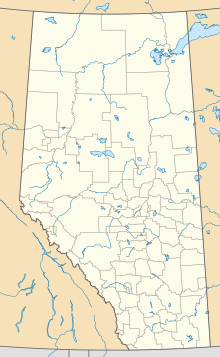
Kingman is a hamlet in central Alberta, Canada within Camrose County. It is located approximately 27 kilometres (17 mi) north of Camrose and has an elevation of 740 metres (2,430 ft).

Acadia Valley is a hamlet in southeast Alberta, Canada within the Municipal District (MD) of Acadia No. 34. The MD of Acadia No. 34's municipal office is located in Acadia Valley.
Marlboro is a hamlet in west-central Alberta, Canada within Yellowhead County. It is located on the Yellowhead Highway, approximately 25 kilometres (16 mi) west of Edson. Sundance Provincial Park is located northwest of the hamlet.
DeBolt is a hamlet in northern Alberta, Canada within the Municipal District of Greenview No. 16. Henry DeBolt, an early postmaster, gave the community his last name.
Brule is a hamlet in west-central Alberta, Canada within Yellowhead County. It is on the northwest shore of Brûlé Lake, approximately 20 kilometres (12 mi) west of Hinton. It has an elevation of 1,040 metres (3,410 ft).
Wimborne is a hamlet in southern Alberta, Canada within Kneehill County. It is located approximately 58 km (36 mi) southeast of Red Deer. It has an elevation of 975 m (3,199 ft).
Red Willow is a hamlet in central Alberta, Canada within the County of Stettler No. 6. It is located on Highway 850, approximately 16 kilometres (9.9 mi) northeast of Stettler and 14 kilometres (8.7 mi) south of Donalda. It has an elevation of 785 metres (2,575 ft).
Winfield is a hamlet in Alberta, Canada within the County of Wetaskiwin No. 10. It is located at the intersection of Highway 13 and Highway 20, approximately 70 kilometres (43 mi) west of Wetaskiwin.
Round Hill is a hamlet in central Alberta, Canada within Flagstaff County. It is located on Highway 834 approximately 29 kilometres (18 mi) northeast of Camrose and has an elevation of 740 metres (2,430 ft).
Benalto is a hamlet in central Alberta, Canada within Red Deer County. It is located approximately 13 kilometres (8.1 mi) west of the Town of Sylvan Lake. Benalto is also recognized by Statistics Canada as a designated place.
Canyon Creek is a hamlet in northern Alberta, Canada within the Municipal District of Lesser Slave River No. 124. It is located on Highway 2, approximately 234 kilometres (145 mi) east of Grande Prairie.
Fawcett is a hamlet in central Alberta, Canada within Westlock County. It is located on Highway 44, approximately 118 kilometres (73 mi) northwest of Edmonton, and four kilometres east of Hubert Lake Wildland Provincial Park.
Flatbush is a hamlet in northern Alberta, Canada within the Municipal District of Lesser Slave River No. 124. It is located 3 kilometres (1.9 mi) west of Highway 44, approximately 135 kilometres (84 mi) northwest of Edmonton.
Grassland is a hamlet in northern Alberta, Canada within Athabasca County. It is on Highway 63, 151 kilometres (94 mi) northeast of Edmonton.
Gwynne is a hamlet in central Alberta, Canada within the County of Wetaskiwin No. 10. It is located on Highway 13, approximately 11 kilometres (6.8 mi) east of Wetaskiwin.
Harvie Heights is a hamlet in Alberta, Canada, within the Municipal District of Bighorn No. 8. It is located within Alberta's Rockies on the Trans-Canada Highway approximately 4 kilometres (2.5 mi) northwest of Canmore and immediately east of the park gate for Banff National Park.
Joussard is a hamlet in northern Alberta within Big Lakes County. It is 2 kilometres (1.2 mi) north of Highway 2, approximately 83 kilometres (52 mi) west of Slave Lake.

Mulhurst Bay, or Mulhurst, is a hamlet in central Alberta, Canada within the County of Wetaskiwin No. 10. It is located 8 kilometres (5.0 mi) northwest of Highway 13A, approximately 38 kilometres (24 mi) southwest of Leduc.
Rochester is a hamlet in northern Alberta, Canada within Athabasca County. It is 3 kilometres (1.9 mi) east of Highway 2, 93 kilometres (58 mi) north of Edmonton.
Tees is a hamlet in central Alberta, Canada, within Lacombe County. It is located 1 kilometre (0.62 mi) north of Highway 12, approximately 40 kilometres (25 mi) northeast of Red Deer.




